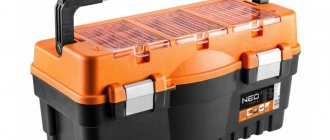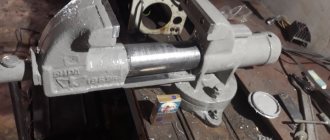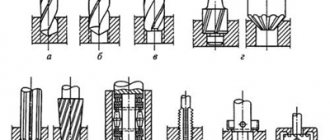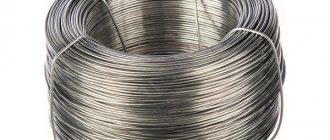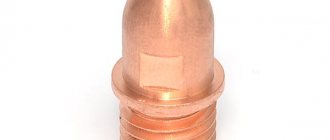In repair, construction, and production, you cannot do without plumbing equipment. The kits differ depending on the area and place of their application. For example, a turner uses a completely different set of tools than a carpenter, electrician, or mechanic. The professional kit includes a large number of accessories. In today's article we will talk about several types of plumbing tools.
Stamps
Die-cut stamps with numbers and all letters of the Latin alphabet, which are useful for stamping various signatures on tools, metal and other surfaces. There are many options to choose from, with font sizes ranging from 2mm to 12.5mm.
Price: from 470 rubles.
Buy
Peculiarities
The scope of application of plumbing equipment determines its features. Devices for cutting, processing or holding metal are made of special alloys of varying degrees of hardening. The electrical installation kit has high requirements for the strength of the material, as well as its insulating properties. Convenience during work plays a special role. The device must be light, durable, and safe at the same time. The handles should fit snugly in the hand, providing greater safety during use. It is important to remember that installation kits often have a narrow specialization. The equipment of the electrical installation kit should not be used in repair work for purposes other than its intended purpose. Their material has a lower hardening, so it can cause injury. Do not use tools without insulating handles during electrical installation.
Sweeps
Rice. Reamers: a - cylindrical with a straight cutting edge; b - cylindrical with a spiral cutting edge; c - conical with a straight cutting edge; g - conical with a spiral cutting edge.
Using reamers, an accurate and cleanly machined hole is obtained. They are used after drilling or boring. The hole for the reamer is drilled 0.03-0.05 mm less than the diameter of the reamer. Reamers are cylindrical and conical. The cutting ribs can be straight or spiral. A reamer with spiral cutting ribs can produce a smoother hole surface. The reamer is rotated with a knob placed on its square shank.
Screw cutting board and dies
For cutting external threads (bolts, screws), screw cutting boards and dies are used.
Rice. Tool for cutting external threads: a - screw cutting board; b - oblique die with split dies; c - split dies; g - solid die; d - straight die for installing a solid die.
Screw-cutting boards are made from tool steel. The board is used for cutting small screws and bolts with a diameter of up to 1/4 inch, for which it has a number of threaded holes of different diameters. Two grooves are made in each hole to obtain cutting teeth.
The dies are either solid (lerks) or split, consisting of two halves. A solid die is installed in a straight die and a complete cut is obtained in one pass. Split dies are installed in an oblique die, and the threads are cut with these dies in several passes, and with each pass the dies are brought closer together by tightening the thrust screw.
Automatic center punch
One of the most necessary tools in plumbing. Allows you to mark places for making holes, leaving small holes that prevent the drill from slipping and increase the accuracy of the work. You just need to place the hardened tip on the surface of the material and press the center punch. There are models with and without a round handle. The first ones are a little more expensive, but much more convenient.
Price: from 191 rubles.
Buy
Scraper
Even with the most careful filing, it is impossible to obtain a sufficiently smooth surface. Therefore, for more precise processing of surfaces, scraping is used with a special tool - a scraper.
Rice. Scrapers: a - rectangular; b - triangular; c - shaped.
The scrapers are made of high-carbon steel containing 1.2-1.3% carbon and are hardened without tempering. In practice, scrapers are made from old files, first grinding off the notch on a whetstone and then sharpening the working edges on a whetstone. The shape of scrapers, like files, can be varied. Most often, a triangular scraper is used for curved surfaces and a rectangular one for planes.
Spanners
This simple but necessary locksmith tool for every home is designed for installing and unscrewing bolts, nuts and other screw connections. To grip products, a pharynx or contoured protrusions and recesses are provided. Wrenches are available in different sizes: this characteristic is indicated on the tool itself, next to the head, and corresponds to the size of the nut or bolt. There are several types of wrenches: box wrenches, socket wrenches, lever wrenches, open-end wrenches, and adjustable wrenches.
The adjustable wrench is distinguished by the ability to adjust the gap between the jaws, which makes it possible to use one tool for bolts and nuts of different sizes. In everyday life, this plumbing tool is indispensable when repairing both plumbing equipment and cars.
Metric thread gauge
A useful device for measuring the pitch of internal and external threads from 0.25 to 6 mm. Useful for monitoring and creating screw threads. Each of the blades is signed and corresponds to its size. It is very simple to use: just attach one of the blades to the threads and look at its markings.
Price: 324 rubles.
Buy
Locksmith work
Preparatory
- Marking
- Metal cutting
- Editing and straightening
- Bending
- cutting
Dimensional processing
- Metal filing
- Hole machining
- Processing of threaded surfaces
Fit
- Scraping
- Sawing
- Fit
- Fitting
- Lapping
- Finishing
- Polishing
First, a rough blank is created and markings are applied according to the drawing. Next, depending on the need, the workpiece is processed by chopping, cutting, bending, and straightening. Then dimensional processing is done, the part is precisely processed to size. And finally, the final finishing of the processed product.
We’ve sorted out the types of work, now let’s look at the plumbing tools themselves.
Files, needle files
A file is a metal bar with a notch that is used to work with metal, plastic, wood and other materials. In contrast, needle files are used for fine filing, cleaning surfaces and fitting small parts. Files and needle files come in various shapes: flat, triangular, diamond-shaped, semicircular, and all of them may be needed when performing metalwork. For home use, it is important to purchase these tools in sets - this will help you cope with manual processing of almost any materials.
Step drills
A set of three step drills that are very useful for making large holes in sheet metal and soft materials. The hexagonal shank is designed specifically for use with a drill or screwdriver. Dimensions - 3–12 mm, 4–12 mm, 4–20 mm.
Price: 364 rubles.
Buy
Nut extractors
A tool similar to the previous one, but for loosening nuts with “licked” edges. It works on the same principle: due to left-sided notches. The head is placed on the damaged fastener, securely engages and allows you to unscrew it. The set contains 13 extractors with a diameter from 8 to 19 mm.
Price: 1,757 rubles.
Buy
Vise
To hold the workpiece, a vice is used - chair, parallel and manual . The chair vice (Figure a) is made of mild steel, and the jaws are welded with tool steel. A spring is inserted between the jaws, which retracts the movable jaw when the screw is unscrewed.
Rice. Vice: a - chair vice; b - parallel; c - manual; 1 - sponges; 2 - screw; 3 - spring; 4 - steel plate.
The movable jaw is secured with its lower part on a hinge so that its upper part describes a circle when the vice is moved apart. Therefore, the jaws are not pressed onto the workpiece being clamped with the entire surface, but only with the edges, as a result of which chair vices are unsuitable for performing precision work. They are used to perform heavy impact work (cutting, riveting, bending).
Parallel vices (Figure b) are cast from cast iron, and hardened steel plates with fine notches on the surface are screwed to the jaws. When clamping an object with cleanly machined surfaces, sheet copper pads are installed on the jaws. Regardless of the size of the jaw opening, they always maintain parallelism and the entire surface is adjacent to the clamped product. Due to the fact that the vice is made of cast iron, it is not recommended to perform impact work (cutting, riveting) on them.
Caring for a vice consists of cleaning it from chips and dirt and regularly lubricating the screw. A hand vice (Figure c) is used to secure small products when filing or drilling them.
Drill
Rice. Drills: a - feather; b - spiral.
Drills come in feather and twist drills. The design of a feather drill is very simple and can be made by a mechanic himself by pulling back a steel bar. The disadvantage of this drill is that it does not remove chips that clog the hole, and that if the tip of the drill bit breaks when sharpening it, the diameter of the cutting edge is reduced. Feather drills can be used relatively successfully for brittle metals (cast iron, bronze).
Twist drills are used more often; they have two grooves made along a spiral, through which the chips are easily discharged out. The cutting edges are sharpened along the groove so that they form an angle of 116-118°. When sharpening correctly, the cutting edges should be the same length and located at the same angle to the drill axis. The correct sharpening of the drill is checked using the template.
Taps
Rice. Taps: a - rough; b - semi-finish; c - finishing.
Taps are used to cut threads in nuts and holes. For this purpose, a set of three taps is required: rough
- (one ring mark on the rod)
- semi-finish (two marks)
- fine (three marks)
Taps from the same set differ in how much the thread tips are cut off. The top of the rough tap is cut off more, the tip of the semi-finish tap is cut less, and the tip of the finishing tap is not cut off at all. The tail part of the tap ends with a square for putting on a collar. A set of taps can also consist of two taps: rough and finishing.
Household or professional
Also, hand tools should be divided into household and professional. What are the differences? What are the advantages and disadvantages?
Professional plumbing tools are significantly more expensive than household ones. Its price is justified by ergonomics, wear resistance, durability, and weight. Buy this tool for daily use. Any mechanic will confirm the advantages of professional hand tools.
Household hand tools are inferior to professional ones primarily in quality. Both in terms of materials used for manufacturing (lower quality steel, powder metals) and in execution (burrs, inconsistencies). But the price, in turn, is minimal.
Well, we’ve sorted out the main aspects of a mechanic’s tool, let’s summarize. Of course, all of the above assortment is not needed for the home. First of all, you need to decide what locksmith operations you will perform. Based on these considerations, select the devices you need. Well, for the home you need some kind of universal set. In my opinion, it will be quite enough to assemble the following plumbing tools and accessories at home:
- ruler;
- roulette;
- center punch;
- pliers;
- needle nose pliers;
- 300 gram hammer;
- side cutters;
- hacksaw for metal;
- screwdriver with a set of bits;
- adjustable wrench;
- set of wrenches.
When purchasing, pay attention to quality. It’s not worth taking the cheapest tool, but there’s no need to take the most expensive one for household needs either.
Requirements
Performance and safety during use mainly depend on the condition of the personal instrument. In the case of industrial use (workshops, factories), the tool is subject to complete removal and subsequent inspection, in accordance with the period and GOST standards. In the case of individual use, the requirements for the set are no less important. When inspecting a personal toolkit, it is necessary to take into account 2 types of damage:
- Critical damage. Regardless of the object or its scope of application, critical defects include: cracks, chips, carbon deposits of rubbing surfaces, peeling, nicks, chips, sagging, traces of burning, melting, traces of rust, corrosion, weakening of welding seams, broken rivet heads or weakening and loosening of the rivets themselves. For devices with wooden handles, critical defects include chips, cracks, sprouting knots, rotting or mold formation. For electrical installation equipment, the main critical defects are melting, burning, cracks, chips, loose fit of insulating handles, notches with sharp corners. Burnout or melting of holding or cutting surfaces (pliers, wire cutters) may occur. In the case of wrenches, socket wrenches, ring wrenches, and heads, it is unacceptable to trim the edges, crack the surfaces and handles. It is not permissible to trim the edges of the knobs used in conjunction with socket wrenches. All these defects lead to tool failure during use. Their use is not safe and often leads to injury.
- Little critical damage. These types of damage include various dents, scratches, chipped paint, illegible markings, and traces of corrosion or rust. All these defects are considered less critical if they are found on non-working surfaces of equipment.
It is worth carefully checking the surfaces of the instruments for dirt or rust. It is not permissible to use a locksmith tool set if traces of oil are found on the surface of its handles and handles. Each tool has its own warranty period. This period is determined not by the store, but by the manufacturer. Careful care of your personal set, when used strictly for its intended purpose, will help avoid breakdowns and damage during operation.


